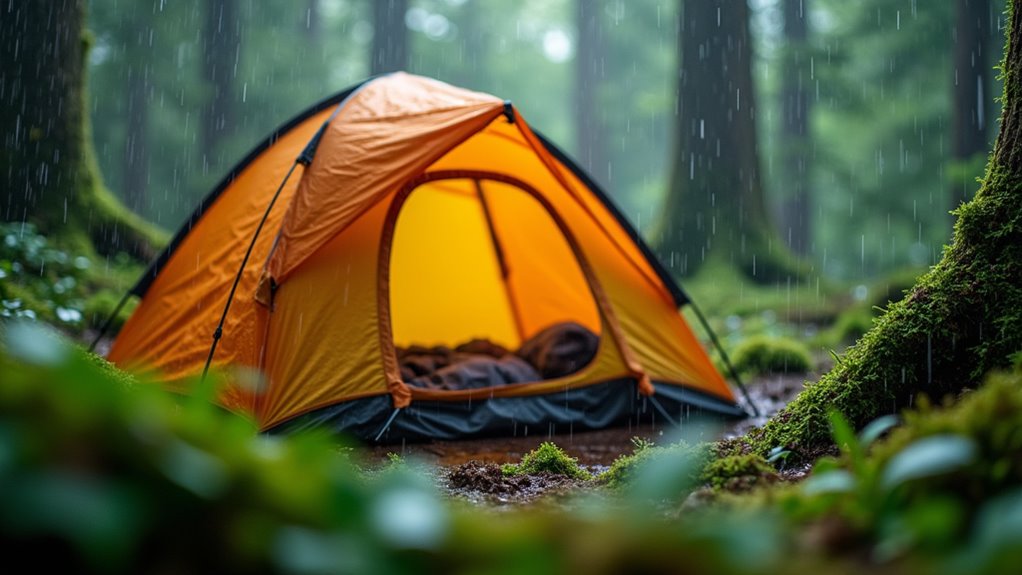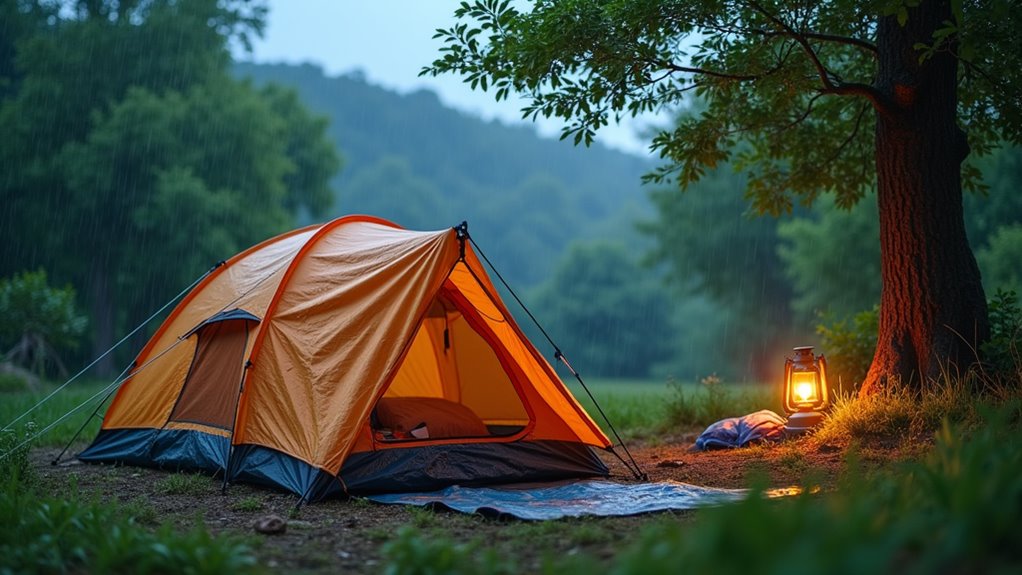How To Protect Tent From Rain
This post contains affiliate links. As an Amazon Associate, we earn from qualifying purchases.
Protect your tent from rain by sealing its seams with a reliable seam sealer and regularly applying waterproof coatings such as polyurethane or silicone sprays. Additionally, ensure the tent is set up on elevated, debris-free ground and kept taut to prevent water pooling. Further details and tips on maintaining your tent’s waterproofing and proper setup techniques will be explained later in the article.
Essential Facts in 30 Seconds
- Apply seam sealer regularly to block water leaks through needle holes.
- Reapply waterproof coatings with spray-on or wash-in products for better water resistance.
- Clean the tent fabric before applying waterproof treatments for optimal adhesion.
- Pitch the tent on elevated ground and remove debris to prevent water pooling.
- Use a tarp underneath and inspect seams to enhance rain protection.
Importance of Seam Sealing

Seam sealing protects your tent from rain and water leaks. It blocks water from entering through tiny holes made by sewing needles. These holes can let water in, even if the fabric looks strong.
Factory seam tape can wear out over time due to heat and dampness. This makes regular seam sealing important to keep your tent dry. Regular maintenance ensures tent longevity and effectiveness in various weather conditions. Applying waterproofing solutions to the seams further enhances their protective capabilities.
Start by cleaning the seams with rubbing alcohol. This helps the sealant stick better. Use a seam sealer that matches your tent fabric. Silicone-based sealers work best on silnylon tents. Polyurethane sealers suit most other fabrics.
Apply the sealant inside the seams. Let it dry completely before using your tent.
Check your seams often for damage or wear. Fixing them early keeps your tent strong and waterproof.
Seam sealing helps your tent last longer and keeps you comfortable in wet weather. It’s a simple step with big benefits for camping trips.
Refreshing Waterproof Coatings
Keep your tent dry by refreshing its waterproof coatings regularly. Check what coatings your tent has, like polyurethane (PU) or silicone. Use spray-on or wash-in products to add Durable Water Repellent (DWR) treatments. These help water bead up and roll off. Applying waterproofing spray can enhance the tent’s resistance to moisture.
Apply thin, even layers and let each dry well before the next coat. This keeps the fabric light and flexible. Regularly conduct inspections for any damage to ensure your waterproofing remains effective.
Watch for wear on urethane coatings, especially on the floor and rainfly inside. Fix small spots using a brush or sponge. Clean your tent fabric first to remove dirt and oils. Dirty fabric stops coatings from sticking properly.
Store your tent in a dry place after use to stop mold and keep coatings strong.
Refreshing coatings can double waterproof life. Water beads stay strong. Your tent stays light and easy to carry. Follow these steps and enjoy dry camping every time.
Cleaning and Preparing Tent Fabric

Cleaning your tent fabric keeps it strong and waterproof.
Begin by brushing off dirt and dust with a soft brush. Clean the canopy and floor separately to avoid mixing dirt.
Fill a tub or bucket with warm water and add mild soap or special fabric cleaner. Soak the fabric and gently rub to remove tough dirt. Rinse the fabric many times to wash out all soap. Soap left behind can damage the fabric.
For mold or bad smells, spray with white vinegar or tea tree oil. Follow directions if using enzyme cleaners. It’s important to address mold or mildew promptly to prevent further damage.
Dry the tent in shade, not direct sun, to protect from UV damage. Make sure the tent is completely dry to stop mold growth.
Taking care of your tent fabric helps it last longer for many trips.
Applying Waterproof Sprays and Liquids
Applying waterproof sprays and liquids keeps your tent dry in rain. Make sure your tent is dry before spraying. Sun-dry it for a few hours if possible.
Use a spray made for your tent’s fabric. Silicone sprays suit nylon and polyester well. Polyurethane sprays can weaken fabric strength. Waterproofing spray is a common choice for canvas materials.
Spray evenly with overlapping strokes. Hold the spray several inches from the fabric. Avoid spraying too much in one spot to stop pooling. Apply two or three layers for best results. Let each layer dry completely before the next.
Check the tent often. If water stops beading on the fabric, spray again. Avoid too much spray to keep fabric soft and breathable. Regular maintenance can enhance the tent’s waterproof capabilities, ensuring it remains effective during wet weather.
These steps help your tent stay dry and comfortable in wet weather.
Preventive Measures During Use

Camping in wet weather needs smart steps to keep your tent dry.
Pick high ground to stop water from gathering under your tent. Stay away from low spots and places where water flows. Clear the ground of sticks and stones. Make the surface flat to help water flow away.
Pull your tent tight to stop water from sitting on the fabric. Dig a small ditch uphill to guide water away. Put a tarp under the tent to keep moisture out, as it acts as a protective barrier from sharp objects that could puncture the tent floor. Add a rain fly for extra water protection.
Look at the seams often. Use seam sealer if you see cracks or holes. Check your tent stakes. Make sure they hold tight in wind and rain. This keeps your tent strong and cozy. Additionally, proper care is essential to maintain waterproof capabilities and prevent leaks during your camping trip.
Frequently Asked Questions
How Often Should I Reseal My Tent Seams?
Check your tent seams every year or two to keep them strong. Rain and rough use wear seams out faster. Fixing seams stops leaks and saves your tent from damage. Good care keeps your tent ready for all your trips. Don’t wait for problems. Act before water gets inside. This simple step protects your gear and makes camping fun.
Can I Use Regular Spray for Waterproofing?
Regular spray is not safe for waterproofing tents. It can harm the fabric or remove the coating. Use sprays made especially for tents. These sprays keep water out and protect the material. Apply the spray evenly and follow the instructions carefully. This way, your tent stays dry and lasts longer. Waterproof sprays made for tents have tested formulas to work well. Don’t risk your gear with regular sprays. Protect your tent the right way.
What Are Signs My Tent Needs Waterproofing?
Water leaking inside your tent shows it needs waterproofing. Fabric that peels or flakes means the coating is gone. Water should bead and roll off the surface. If it soaks in instead, your tent lost protection. Check your tent often for these signs. Waterproofing keeps your tent dry and strong. Many campers waterproof their tents every 1-2 years. This simple step prevents damage and extends tent life.
Is It Safe to Waterproof My Tent Indoors?
Waterproofing your tent indoors can be risky without fresh air. Use fans and open windows to keep air moving. Chemicals in waterproof sprays can cause trouble if you breathe them in too much. Always waterproof tents outside or in places with good airflow. This keeps you safe and your tent dry.
Can I Waterproof a Tent With Damage?
You can waterproof a tent even with damage. About 70% of campers fix their tents using repair kits and waterproof sprays. These methods stop water from leaking and keep the tent dry during rain. Patching holes and sealing seams helps protect your gear. Repairing your tent saves money and extends its life. Simple tools and products work well for most damages. A dry tent keeps you safe and comfortable outdoors.
Conclusion
Protecting your tent from rain keeps you dry and comfortable outdoors. Seal all seams carefully to stop water leaks. Use waterproof sprays like Nikwax Tent & Gear SolarProof for extra protection. Reapply waterproof coatings each season to maintain strength. A strong rainfly also helps shield your tent from heavy rain. Set up your tent on high ground to avoid puddles. Keep your tent clean and dry before storing it. These steps prevent water from soaking your gear and clothes. Stay dry and enjoy nature, no matter the weather.
